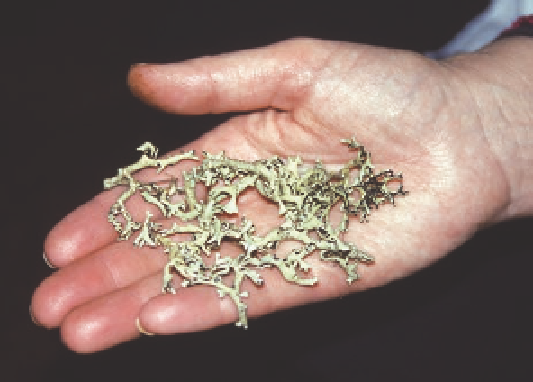Geoscience Reference
In-Depth Information
Fig. 6.6. the amount of nitrogen, mea-
sured as grams per square meter, in the
major components (boxes) of a grassland
ecosystem, and the flows between the
components (arrows), measured in grams
per square meter per year. Based on data
in Woodmansee et al. (1981).
NITROGEN
Atmospheric
deposition
0.5
Volatilization
Fixation
<0.1
Animals
0.01
24
Stems
Lvs
3
2.3
Detritus
6
Soil surface
Roots
7
1.3
19
Soil organic
matter N
333
Animals
0.12
3
Soil
solution
2
Microbes
5.2
Outflow
0.1
(erosion)
bacteria accounts for only about 7 percent of the annual
nitrogen inputs on a short-grass prairie south of chey-
and the microbial mineralization of soil organic mat-
ter, of which there is a large quantity. the sources are
diverse, but evidence suggests that nitrogen is a limiting
factor for plant growth in grasslands, especially during
wetter-than-average growing seasons.
27
this observation has led some managers to conclude
that fertilizing native rangelands might be profitable.
indeed, more forage of higher protein content could
result. However, several concerns have been identified:
(1) fertilizing only part of a rangeland could result in
selective overgrazing as livestock seek out more nutri-
tious forage; (2) certain undesirable weeds may be
favored; and (3) despite increases in forage quality and
quantity, fertilization is not yet economical. changes in
species composition following fertilization are typically
small unless the amounts applied are massive (>150
pounds of nitrogen/acre/year), but there is a chance that
cool-season species could be favored, because they grow
in the spring when nitrogen is more likely to be limiting
than water.
28
Although annual nitrogen inputs may be low, this is
of little consequence if losses are also low and if there
is considerable nitrogen in the belowground biomass
and soil organic matter. Francis clark, an agricultural
research scientist in colorado, concluded that most
plant needs for nitrogen aboveground are met by the
transfer of stored nitrogen from the root system to the
leaves, with additional nitrogen being made available
by the mineralization of organic matter and microbial
Fig. 6.7.
Xanthoparmelia chlorochroa,
a common lichen on the
soil surface in Wyoming grasslands and shrublands.



















































Search WWH ::

Custom Search